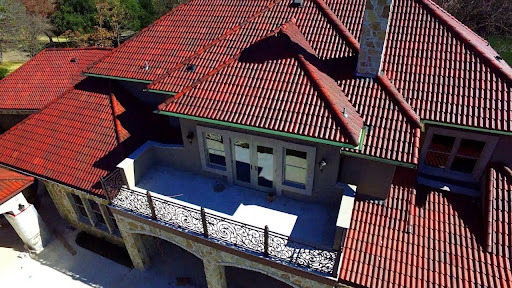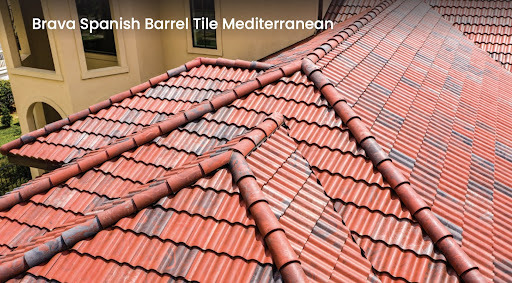
Mission style architecture has its roots in the buildings and homes found in Spain where most of the exterior elements on a home were sourced from local materials. Stucco and brick were popular sidings and both had clay in them. It was a logical step to incorporate the advantages of clay into a roofing product. The buildings in Spain that found themselves covered with stucco and red clay barrel tile roofs were associated with the religious movement of the era and were called missions. As the American west was being populated by Europeans, many of the residents copied the same style of building into their new homes, and the design became known as mission style.
Is Clay The Best Material For A Mission Style Roof?
Made popular in the American Southwest during the early 1900s, the mission style home, sometimes called missionary revival, has many distinctive features. The home’s exterior is usually stucco or stone, with rounded windows and clay tile roofs. Of these elements, the trademark tile roof sets this design apart.

The roof of a mission style home has traditionally been clay because of its ability to:
- Withstands high winds
- Repel water
- Keep the sun’s heat away from the home’s interior by radiating the absorbed heat back to the atmosphere in the cool evening
Clay was also readily available as a local resource and easy to mold into shape. Clay roofing tiles have advantages over other types of roofing. With proper maintenance they can last more than 50 years, and they are extremely fire-resistant which is important for homes in the west and southwest, where the mission style roof is normally found.
Modern Materials Used For Mission Style Roofing
Clay is still a major player in the roofing market for this style of home, but there have been a number of new materials introduced that mimic the look of a clay barrel tile. Each material offers some advantages, but there are often serious disadvantages that make them less than desirable as a roof covering.
Concrete
Concrete became popular as a roof tile after World War II when regular building materials were scarce. The immediate draw is its inherent strength and longevity. In addition, the raw materials are relatively inexpensive and they can be molded into many shapes. However, there are some drawbacks:
- Extremely heavy, mayrequire additional structural support
- If not properly treated it will absorb water and will become heavier.
- Color fades over time making it difficult to replace a piece without it being noticeable
- Underlayment doesn’t last as long as the concrete tiles and because of the weight of the tiles, the underlayment could need replacing after 20 years
Metal
Metal roofing has been around since the 1800s, but it has only been recently that a wide variety of shapes and sizes have been available - among them the clay barrel tile. Metal roofs are long-lasting and lightweight compared to clay and concrete, but still have disadvantages:
- Can dent if hail or other heavy objects fall on them
- Do a poor job of removing heat from the roof
- Have a high installation cost compared to other products
- Noisy
- Expands and contracts and the fasteners become loose over time requiring replacement

Rubber
Rubber shingles are available in various designs and colors but the most common shapes are slate and shake look-alikes. Rubber has the advantage of being made from recycled material, is energy efficient, resists high winds and is resistant to cracks and dents. On the other hand, rubber shingles:
- Have a short life span compared to composite shingles and natural clay
- Are expensive compared to other 30 year shingles
- Give off a strong smell when initially installed. It does go away over time, but if you have an aversion to the smell of plastics or rubber, this may not be for you.
Plastic
Sometimes placed in the same category as composite roofing tiles, they are not the same thing. Plastic roof tiles are not eco-friendly because they cannot be recycled. They are thin, lightweight and look good when initially installed, however, eventually the shiny surface of the plastic becomes evident and they no longer look as natural. In addition, most plastic shingles contain polypropylene which has a tendency to crack in the winter and stretch in the summer.
Composite
Composite barrel roof tiles have all the advantages of their competitors without the negative side effects. Most are made from recycled synthetic materials and can be recycled over and over making them an excellent eco-friendly choice for the environmentally-conscious consumer. They come in a variety of colors, carry long warranties and perfectly mimic the clay barrel tiles on a mission style roof. Advantages include:
- Lighter than clay and concrete and less expensive to install
- Don’t require specialty installers
- Require almost zero maintenance
Where To Get The Best Composite Barrel Tile Roofing
Brava Spanish Barrel Tiles are leading the industry in quality and performance. They have taken the synthetic composite shingle market to the next level with their warranties and options.

- 50-year limited warranty
- Available in an unlimited selection of colors, including custom colors
- Class A and C fire rating
- Class 4 impact rating
- Can be nailed or screwed down for higher wind ratings
- Lightweight, no additional roof support required
Our website is full of helpful information including videos and CAD drawings to help with installation. Contact us today for free samples and find out why so many homeowners are choosing Brava Roof Tile for their synthetic composite roof tiles.



